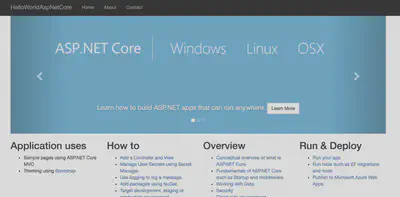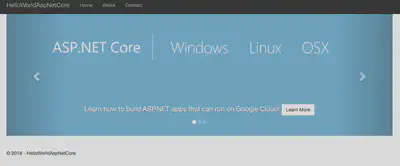点击查看目录
本文为翻译文章,点击查看原文。
当学习像Istio这样的新技术时,我推荐看一看项目自带的示例。Istio 包含了一些示例程序,但都有各种各样的不足。比如说BookInfo就是很好的一个应用。但是对我来说,它太冗长,服务太多,而且文档似乎专注于管理 BookInfo 应用程序,而不是从头构建。另外还有一个小一点的示例-helloworld,但是它仅关注于自动伸缩。
在这篇文章中,我想从基础讲起,并向您展示如何从头开始构建支持 Istio 的“HelloWorld”应用程序。要记住的一点是,Istio 只管理您应用的流量,应用程序生命周期由底层平台 Kubernetes 管理。因此,您需要了解容器和 Kubernetes 基础知识,并且需要了解 Istio 路由原语,例如 Gateway,VirtualService,DestinationRule。我假设大多数人都知道容器和 Kubernetes 基础知识。我将在本文中专注于介绍 Istio 路由。
基本步骤
这些大致是创建 Istio“HelloWorld”应用程序的步骤:
- 创建一个 Kubernetes 集群并安装带有自动 sidecar 注入的 Istio。
- 使用您选择的语言创建一个 HelloWorld 应用程序,基于这个程序创建一个 Docker 镜像并将其推送到公共镜像存储库。
- 为容器创建 Kubernetes Deployment 和 Service。
- 创建Gateway以启用到集群的 HTTP(S)流量。
- 创建VirtualService以通过 Gateway 公开 Kubernetes 服务。
- (可选)如果要创建应用程序的多个版本,请创建DestinationRule以定义可从 VirtualService 引用的子集。
- (可选)如果要从服务网格调用外部服务,请创建ServiceEntry。
我不会在本文中介绍步骤 1 和 2,因为它们不是 Istio 特有的。如果您需要有关这些步骤的帮助,可以查看我在本文末尾提到的 codelabs。第 3 步也不是 Istio 特定的,但它是其他一切的先决条件,所以我们从那开始。
Deployment 和 Service
正如我所提到的,应用程序生命周期由 Kubernetes 管理。因此,您需要从创建 Kubernetes Deployment 和 Service 开始。我有一个容器化的 ASP.NET 核心应用程序,容器镜像我已经推送到谷歌容器注册表。让我们从创建一个 aspnetcore.yaml 文件开始:
apiVersion: v1
kind: Service
metadata:
name: aspnetcore-service
labels:
app: aspnetcore
spec:
ports:
- port: 8080
name: http
selector:
app: aspnetcore
---
apiVersion: extensions/v1beta1
kind: Deployment
metadata:
name: aspnetcore-v1
spec:
replicas: 1
template:
metadata:
labels:
app: aspnetcore
version: v1
spec:
containers:
- name: aspnetcore
image: gcr.io/istio-project-212517/hello-dotnet:v1
imagePullPolicy: Always #IfNotPresent
ports:
- containerPort: 8080
创建 deployment 和 service:
$ kubectl apply -f aspnetcore.yaml
service "aspnetcore-service" created
deployment.extensions "aspnetcore-v1" created
到现在为止还没有专门讲到 Istio。
Gateway
我们现在可以回到 Istio 路由了。首先,我们需要为服务网格启用 HTTP/HTTPS 流量。为此,我们需要创建一个Gateway。Gateway 描述了在网络边缘运行的负载均衡器,用于接收传入或传出的 HTTP / TCP 连接。
让我们创建一个 aspnetcore-gateway.yaml 文件:
apiVersion: networking.istio.io/v1alpha3
kind: Gateway
metadata:
name: aspnetcore-gateway
spec:
selector:
istio: ingressgateway # use istio default controller
servers:
- port:
number: 80
name: http
protocol: HTTP
hosts:
- "*"
创建 Gateway:
$ kubectl apply -f aspnetcore-gateway.yaml
gateway.networking.istio.io "aspnetcore-gateway" created
我们已经为集群启用了 HTTP 流量。我们需要将之前创建的 Kubernetes 服务映射到 Gateway。我们将使用 VirtualService 执行此操作。
VirtualService
VirtualService实际上将 Kubernetes 服务连接到 Istio 网关。它还可以执行更多操作,例如定义一组流量路由规则,以便在主机被寻址时应用,但我们不会深入介绍这些细节。
让我们创建一个 aspnetcore-virtualservice.yaml 文件:
apiVersion: networking.istio.io/v1alpha3
kind: VirtualService
metadata:
name: aspnetcore-virtualservice
spec:
hosts:
- "*"
gateways:
- aspnetcore-gateway
http:
- route:
- destination:
host: aspnetcore-service
请注意,VirtualService 与特定网关绑定,并定义引用 Kubernetes 服务的主机。
创建 VirtualService:
$ kubectl apply -f aspnetcore-virtualservice.yaml
virtualservice.networking.istio.io "aspnetcore-virtualservice" created
测试 app v1 版本
现在可以开始测试我们的应用了,首先需要拿到 Istio Ingress Gateway 的外部 IP 地址。
$ kubectl get svc istio-ingressgateway -n istio-system
NAME TYPE CLUSTER-IP EXTERNAL-IP
istio-ingressgateway LoadBalancer 10.31.247.41 35.240.XX.XXX
当我们用浏览器访问外部地址时,我们应该看到 HelloWorld ASP.NET Core 程序。

DestinationRule
在某些时候,您希望将应用更新为新版本。也许你想分割两个版本之间的流量。您需要创建一个DestinationRule来定义那些版本,在 Istio 中称为子集。
首先,更新 aspnetcore.yaml 文件,用 v2 版本的容器来定义 v2 的部署(Deployment):
apiVersion: v1
kind: Service
metadata:
name: aspnetcore-service
labels:
app: aspnetcore
spec:
ports:
- port: 8080
name: http
selector:
app: aspnetcore
---
apiVersion: extensions/v1beta1
kind: Deployment
metadata:
name: aspnetcore-v1
spec:
replicas: 1
template:
metadata:
labels:
app: aspnetcore
version: v1
spec:
containers:
- name: aspnetcore
image: gcr.io/istio-project-212517/hello-dotnet:v1
imagePullPolicy: Always #IfNotPresent
ports:
- containerPort: 8080
---
apiVersion: extensions/v1beta1
kind: Deployment
metadata:
name: aspnetcore-v2
spec:
replicas: 1
template:
metadata:
labels:
app: aspnetcore
version: v2
spec:
containers:
- name: aspnetcore
image: gcr.io/istio-project-212517/hello-dotnet:v2
imagePullPolicy: Always #IfNotPresent
ports:
- containerPort: 8080
创建一个新的部署(Deployment):
$ kubectl apply -f aspnetcore.yaml
service "aspnetcore-service" unchanged
deployment.extensions "aspnetcore-v1" unchanged
deployment.extensions "aspnetcore-v2" created
如果刷新浏览器,你可以看到 VirtualService 在 v1 和 v2 版本之间切换:


这个结果是预料之中的,因为这两个版本都暴露在相同的 Kubernetes 服务之后:aspnetcore-service。
如果您想将服务仅限于 v2 该怎么办?可以通过在 VirtualService 中指定子集来完成,但我们需要首先在 DestinationRules 中定义这些子集。DestinationRule 本质上将标签映射到 Istio 子集。
创建一个 aspnetcore-destinationrule.yaml 文件:
apiVersion: networking.istio.io/v1alpha3
kind: DestinationRule
metadata:
name: aspnetcore-destinationrule
spec:
host: aspnetcore-service
trafficPolicy:
tls:
mode: ISTIO_MUTUAL
subsets:
- name: v1
labels:
version: v1
- name: v2
labels:
version: v2
创建 DestinnationRule:
$ kubectl apply -f aspnetcore-destinationrule.yaml
destinationrule.networking.istio.io "aspnetcore-destinationrule" created
现在,你可以在 VirtualService 指向 v2 子集:
apiVersion: networking.istio.io/v1alpha3
kind: VirtualService
metadata:
name: aspnetcore-virtualservice
spec:
hosts:
- "*"
gateways:
- aspnetcore-gateway
http:
- route:
- destination:
host: aspnetcore-service
subset: v2
更新 VirtualService:
$ kubectl apply -f aspnetcore-virtualservice.yaml
virtualservice.networking.istio.io "aspnetcore-virtualservice" configured
现在再刷新浏览器,你应该只会看到 v2 版本的内容了。
ServiceEntry
最后我大概提一下ServiceEntry。所有外部流量在 Istio 中都是默认被阻断了的,如果你需要启用外部流量就需要创建一个 ServiceEntry 来列出所有的已经启用外部流量的协议和主机。你可以从这里了解更多信息,我在这篇文章中就不多做阐述了。
希望这篇文章对你有所助益!如果你还想了解更多,这里有一个系列更详细的阐述了这篇文章提到的所有概念和解释:
